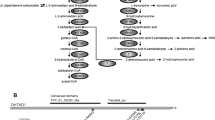Abstract
We have examined the molecular basis of Segawa's syndrome in six families with seven affected children. In one family two siblings with this disease carried a point mutation in exon 11 of the tyrosine hydroxylase gene, resulting in an amino acid exchange of Gln381 to Lys381. These results suggest that a change in tyrosine hydroxylase causes this form of Segawa's syndrome.
Similar content being viewed by others
References
Bartholomé K (1983) Deficiency of tyrosine hydroxylase or tryptophan hydroxylase: a possible cause of two hypothetical metabolic diseases. Acta Paediatr Scand 72:921–922
Egeland JA, Gerhard DS, Pauls DL, Sussex JN, Kidd KK, Allen CR, Hostetter AM, Housman DE (1987) Bipolar affective disorders linked to DNA markers on chromosome 11. Nature 325:783–787
Fletcher NA, Holt IJ, Harding AE, Nygaard TG, Mallet J, Marsden CD (1989) Tyrosine hydroxylase and levodopa responsive dystonia. J Neurol Neurosurg Psychiatry 52:112–114
Görke W, Bartholomé K (1990) Biochemical and neurophysiological investigation in two forms of Segawa's disease. Neuropediatrics 21:3–8
Grima B, Lamouroux A, Boni C, Julien J-F, Jaroy-Agid F, Mallet J (1987) A single human gene encoding multiple tyrosine hydroxylases with different predicted functional characteristics. Nature 326:707–711
Lerman LS, Silverstein K (1987) Computational simulation of DNA melting and its application to denaturing gradient gel electrophoresis. Methods Enzymol 155:482–501
Myers RM, Maniatis T, Lerman LS (1987) Detection and localization of single base changes by denaturing gradient gel electrophoresis. Methods Enzymol 155:501–527
Nagatsu T, Ichinose H (1991) Comparative studies on the structure of human tyrosine hydroxylase with those of the enzyme of various mammals. Comp Biochem Physiol C 98:203–210
Nygaard TG, Wilhelmsen KC, Risch NJ, Brown DL, Trugman JM, Gilliam TC, Fahn S, Weeks DE (1993) Linkage mapping of the dopa-responsive dystonia (DRD) to chromosome 14q. Nature Genet 5:386–391
Polymeropoulus MH, Xiao H, Rath DS (1991) Tetranucleotide repeat polymorphism at the human tyrosine hydroxylase gene (TH). Nucleic Acids Res 19:3753
Segawa M, Ohmi K, Itoh S (1971) Childhood basal ganglia disease with remarkable response to l-DOPA, “hereditary basal ganglia disease with marked diurnal fluctuations”. Therapie 24:667–672
Author information
Authors and Affiliations
Rights and permissions
About this article
Cite this article
Lüdecke, B., Dworniczak, B. & Bartholomé, K. A point mutation in the tyrosine hydroxylase gene associated with Segawa's syndrome. Hum Genet 95, 123–125 (1995). https://doi.org/10.1007/BF00225091
Received:
Revised:
Issue Date:
DOI: https://doi.org/10.1007/BF00225091




